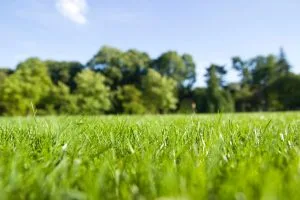Mowing the lawn seems like a simple enough task, if not tiresome and time-consuming. But each type of turf comes with its own set of rules. Mow it too short and you risk damaging your lawn. Leave it too long and you’ll be mowing it again before you know it. So, how low should you go when you mow Kentucky bluegrass?
Types of Grass
The rules of lawn cutting depend on the type of grass and the variety within that type. To add to the confusion, many seed types are blended to cater to specific needs. For example, seed blends exist to create lawns that better withstand high traffic, too much shade, or not enough water.
The two main types of grasses are cool season and warm season. Most often found in the southern states, warm season grasses love the heat and grow best during the summer months. Zoysia, St. Augustine, and centipedegrass are found in the southern regions. Bermudagrass is also a popular choice because it is very drought tolerant.
The area we live in is home to cool season grasses. These include perennial ryegrass, tall fescue, and fine fescue. The most popular cool season grass is Kentucky bluegrass because it offers many desirable qualities for the area’s climate. It tolerates cold weather and recovers nicely from the usual wear and tear. When properly cared for, it forms a dense, dark green carpet that creates great curb appeal.
Proper Height to Mow Kentucky Bluegrass
Because Kentucky bluegrass is a cool-season grass, its active growth time is during the spring and fall. Generally, cool-season grasses perform best when left on the high side. The typical height range in which cool season grasses thrive is between 2-1/2 to 4 inches. But more specifically, the best height to mow Kentucky bluegrass is 2 to 3 inches, depending on the specific variety. A good rule of thumb is not to remove more than one-third of the blade height during a single cutting. This goes for any type of grass.
Let Us Take the Confusion out of Lawn Maintenance
How often you mow your lawn depends on the type of turf, time of year, and environmental elements. If you mow it too often or too short, it puts too much stress on the grass, resulting in brown or bare spots. This leaves the lawn vulnerable to weeds, pests, and disease.
If you have any questions on turf type, mowing height, or mowing frequency, or if you are unsure how to properly mow Kentucky Bluegrass, call in an expert. Contact Free Spray Lawn Care at 419-529-5296. We’ll help you keep your lawn a cut above the rest.



Comments (0)
Thanks for your comment!
Thanks for your feedback! Your comments have been successfully submitted! Please note, all comments require admin approval prior to display.
Error submitting comment!
There is a problem with your comment, please see below and try again.